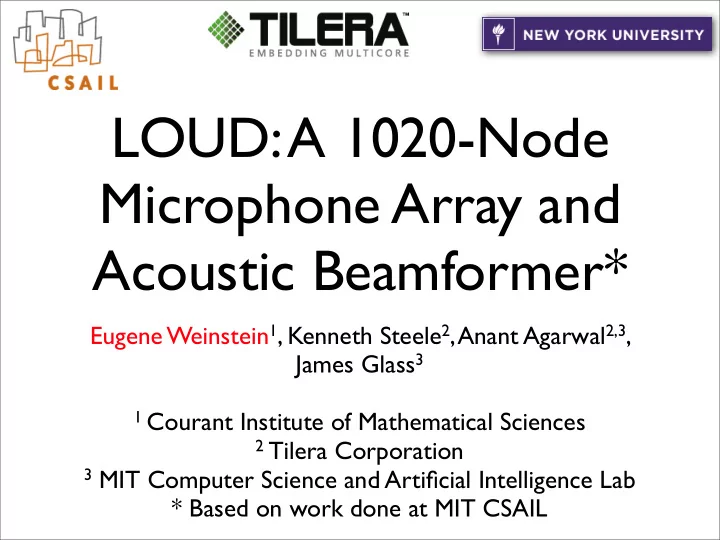

LOUD: A 1020-Node Microphone Array and Acoustic Beamformer* Eugene Weinstein 1 , Kenneth Steele 2 , Anant Agarwal 2,3 , James Glass 3 1 Courant Institute of Mathematical Sciences 2 Tilera Corporation 3 MIT Computer Science and Artificial Intelligence Lab * Based on work done at MIT CSAIL
Introduction • Recording sound in high-noise settings is difficult • e.g., noisy lab or conference room • Can use close-talking microphones (e.g., lapel mic) • However, an untethered solution is more natural • Idea: use software-steerable microphone arrays • Isolate and amplify sound using beamforming • Target application: speech recognition 2
Large Microphone Arrays • Large acOUstic Data (LOUD) array: 1020 microphones • Microphone array gain increases linearly with the number of microphones • Past large-array speech recognition experiments scarce • Processing large quantities of data in real-time is a compelling application for novel computing architectures • LOUD generates 400 Mbits/sec • We use Raw, a 16-tile parallel architecture 3
Acoustic Beamforming • Selectively amplify a sound source at a particular location • Take advantage of sound propagation through space Sound • Use simple delay-and-sum beamforming Source t8 … t1 t7 Microphones … Delay 0 t8-t7 t8-t1 +
Two-microphone PCB • On-board A/D converter feeds into CPLD • Data streamed to CPU using time-division multiplexing 5
1020-Microphone Array 6
Microphone Positions • Automated procedure to calibrate microphone positions • Play a test audio “chirp” through a speaker • Record with reference mic at speaker position and at each array mic • Peak of cross-correlation function between reference, array microphones gives propagation delay • Solve for precise array geometry 7
Experiments • Setting: extremely noisy hardware lab • Subject and “interferer” talking at the same time • Goal: demonstrate that speech recognition accuracy improves with microphone array size • Speaker-independent recognizer for digit strings • Record 150 utterances with interferer, 110 without • Baseline: high quality close-talking mic, 80 utterances 8
Recognition Accuracy • Word error rate 100 Array with interferer Array without interferer (WER) decreases Close � talking microphone 90 with array size 80 70 • WER drops by 87% Word Error Rate (%) 60 (w/ interferer), 91% 50 (no interferer) from 40 one to 1020 mics 30 • Accuracy approaches 20 10 close-talking 0 0 1 2 3 10 10 10 10 microphone levels! Number of Microphones 9
LOUD Demo 10
Summary/Future Work • LOUD allows high-quality untethered recording in very noisy settings • Speech recognition experiments demonstrate benefit of large arrays • Future work: • Implement more sophisticated beamforming techniques • Automatic speaker tracking • Conduct more experiments with different geometries, noise settings 11
Recommend
More recommend